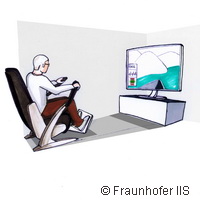Achieving lifelong fitness
More and more Europeans are living longer. It has been predicted that by 2050, the number of people in the EU aged 65 and above will grow by 70%, while the number of people aged over 80 will increase by 170%. This raises important challenges for the 21st century: meeting the higher demand for healthcare; the need to adapt health systems to the needs of an ageing population and ensuring the sustainability of welfare with a smaller workforce. Older adults are at higher risk from developing chronic illnesses and disabilities. These conditions include diabetes, arthritis congestive heart failure, Parkinson's and Alzheimer's disease. Many have to be hospitalised or put in nursing homes, as many lose the ability to live independently at home. Chronic conditions are the leading cause of death among older adults. Because older people have different healthcare requirements, health systems need to adapt in order to provide adequate care and remain financially sustainable. It has been established that the longer an older person stays at home, the better it is for their health. A second issue is that the longer a person is fit and stays fit, the easier it is to keep illnesses away. Many seniors however feel discouraged by certain fitness barriers, such as chronic health conditions or concerns about injury or falls. In some cases, if the person has never exercised before, they may not know where to begin. Ongoing health problems or disabilities can also stop people from getting active. Certain diseases, such as Parkinson's also inhibit a person's ability to perform simple tasks such as walking. In order to address these issues, researchers have developed an intelligent armchair called GEWOS, which can motivate people to keep themselves healthy and fit. The project, entitled "GEWOS" (an abbreviation for the German "Gesund wohnen mit Stil" meaning Healthy Living in Style), is funded by the German Federal Ministry of Education and Research (BMBF) and is being carried out by six business and research partners, in addition to the IIS. The goal is to create an assistance system that is easy to operate and will be accepted by senior citizens. In addition to the exercise armchair, GEWOS also includes a web platform as a central interface for information management. The platform can be used to call up health-relevant data and to integrate physicians and health experts. On the outside, GEWOS looks like a conventional armchair. Even when you sit down you don't notice any difference. But first glances can be deceiving. A glimpse inside the armchair reveals sensors, circuit boards and all kinds of wiring. The microsystem technology built into the seat cushions, backrest and armrest constantly measures the state of health of the seated person. "GEWOS measures the key bodily functions and determines the correct sitting posture. If the acquired values deviate from specifications, the system shows the user how he or she can practice improving endurance or sitting in a healthier position," explains Sven Feilner of the Image Processing and Medical Technology Department at IIS. A tablet PC applied to the armchair transmits data to the TV via Bluetooth and WLAN. Feilner describes the system: "At a glance the user can view trends in pulse rate, blood oxygen saturation, blood pressure or weight over a certain period of time. A virtual health assistant uses the recorded data to come up with exercise plans tailored to the user and updates these plans based on the progress made". If the values fall outside a prescribed range the health assistant may recommend more exercise. Then, the armchair is transformed into a rowing machine of the kind seen in fitness studios. The armrests become the oars, and a support for the rower's feet pops out below the seat. Individual exercises are easy to call up through the television. "Here too the sensors record all of the values and the health assistant lets the user know if any exercises are not being executed correctly," Feilner continues. The armchair has already passed its first test with flying colours. Last year, at the Ambient Assisted Living Conference 2012, 100 senior citizens tested the GEWOS armchair and ranked it in first place, among 14 different assistance products. Looking to the future, next steps include a comprehensive evaluation of the finishing touches. "We're very confident that we'll be able to market the armchair together with our partners in the foreseeable future," says Feilner. The scientists in Erlangen want to use people's natural play instincts to help them add cognitive games to the system's capabilities. Senior citizens should not just row against imaginary competitors; memory games should also encourage them to participate. By making a mental note of individual segments of the armchair, for instance, and then placing weight on them using the corresponding part of their body. The truth is that older people need to keep moving, and that exercising is crucial to staying energetic and healthy. Reaping the rewards of exercise does not necessarily require strenuous workouts or trips to the gym. As this project has shown, it's about adding more movement and activity, even in very small ways. "The exercise armchair promises to give seniors an easy and motivating way to stay fit," Feilner concludes.For more information, please visit: Fraunhofer Institute for Integrated Circuits IIShttp://www.fraunhofer.de/en/press/research-news/2013/february/the-armchair-as-a-fitness-trainer.html
Countries
Germany



